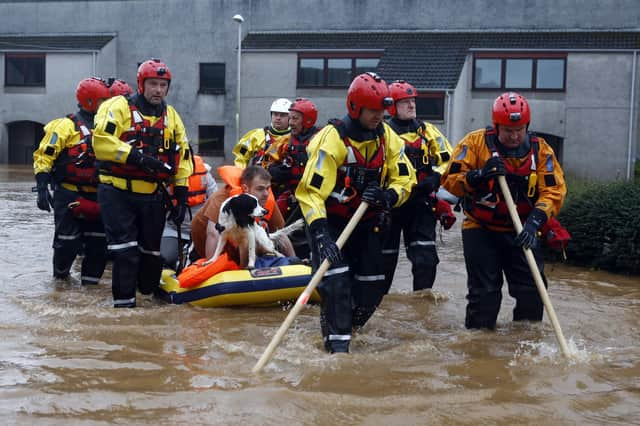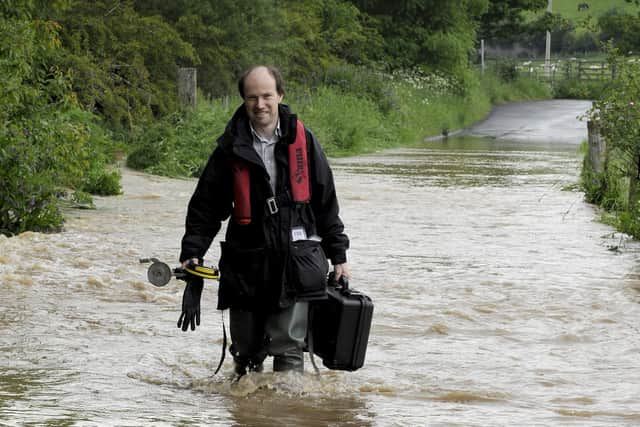Flooding survival guide: The importance of early warnings, preparation and fortitude


Tragically, seven people – including three north of the border – lost their lives as water surged and trees were blown down.
Hundreds of homes were evacuated in parts of eastern Scotland, with many people still unable to return. Around 400 people living around Brechin were advised to leave as the town’s flood defences were breached.
Advertisement
Hide AdAdvertisement
Hide AdMore than 670mm of rain – nearly three and a half times last year’s monthly total for October – fell across Scotland in just three days.
As much as 200mm of rain fell in the wettest areas, according to the Met Office, and October 19 was “by a wide margin” the wettest day on record for the county of Angus since records began in 1891.
But the deadly flooding did not come about solely because of Storm Babet. The situation was exacerbated by a severe wet period earlier in the month which had left many areas waterlogged, reducing the land’s capacity to soak up more liquid and resulting in a dramatic and rapid rise in river levels.
And the current outlook remains pretty bleak, with more wet weather warnings stretching into next week and some of the areas worst hit by Babet getting further heavy downpours.
Despite the recent devastation, however, things could have been worse.


Lorna Philip has been observing the happenings from both a personal and professional perspective.
As a professor in the University of Aberdeen’s geosciences, geography and environment department, she has been researching the human impacts of flooding for several years and has shared findings with the Scottish Environment Protection Agency (Sepa) and other bodies involved in flood-risk management measures.
She believes today’s systems are vastly improved, with the likes of the Met Office’s severe weather warnings and Sepa’s Floodline helping to ensure people are properly advised when risky conditions are expected and, crucially, giving them time to take action.
Advertisement
Hide AdAdvertisement
Hide AdThe Met Office had issued a rare red alert for parts of the country – the highest level of weather warning, indicating “danger to life” – the first since 2020.


Sepa’s services were able to give information on a more local level, with warnings and alerts for particular areas and rivers.
“It’s not an exact science, but I think the forecasters did warn people that this was going to be bad,” she said.
“Of course, what they can’t say is exactly where it is going to hit the worst. I don’t think they will ever be able to do that.”
According to the professor, it’s important to get the information out there via multiple channels to try to reach as many people as possible.
“I was aware over last week that there were things coming out from Sepa, from the police, from local news sites, on the radio, in newspapers.
“You can never get hold of everybody but I think this effort to repeatedly put out warnings and do it in lots of different ways meant that more people were told it was going to be bad.
“They also got information on what they could do themselves, like where they could get sandbags. It means they don’t feel completely helpless.
Advertisement
Hide AdAdvertisement
Hide Ad“When the evacuation order was issued in Brechin, although not everybody decided to leave, because it was issued in good time people were able to do what they could in their homes – if they had an upstairs they could move things up there, they could find important documents, make sure the dog was safe, move their car.”
The professor was part of the team involved in a three-year study looking at the impacts of flooding on residents of the north-east of Scotland in the winter of 2015/16, prepared for the Centre of Expertise for Waters (Crew).
Their findings have provided unique insights into the toll such events have on those affected and highlighted the sort of preparation and actions people can take before, during and after to keep safe and protect their well-being.
Giving people as much information in advance is absolutely crucial so they know what to do when the time comes, she says.
“It can’t stop the devastation of being flooded but if it allows somebody to, for instance make sure they have collected all their important family photos or other important sentimental items in the house, pack them up and take them with them, that can make the recovery that little bit easier.
“We have found out from people who have experienced flooding that it’s not just losing their carpets and the washing machine, things that you can go out and replace, it is losing things that really mean something to them – which might not have a lot of monetary value but not having them any more is really quite painful.”
Structural defences have a big part to play in reducing the risk of flooding, with three main types being installed – fixed flood walls, usually made of concrete; demountable devices which can be moved into a vulnerable place ahead of a flood or used to raise existing walls; and glass barriers, which have the advantage of allowing people to continue to enjoy the visual aspects of a river while also providing protection.
But barriers are not infallible – as was seen in Brechin last week.
Advertisement
Hide AdAdvertisement
Hide AdDr Andrew Black, reader in physical geography at the University of Dundee, says engineered solutions like walls can work together with other measures such as upstream reservoirs and natural flood plains to help control excess water.
“Different catchments are vulnerable to different types of flooding situations,” he explained.
“Sometimes you get a community at risk of flooding where the river might be several hundred or thousands of kilometres in its catchment size – the amount of water that’s going to be coming at the place in a flood situation is huge and may well exceed what purely green solutions by themselves can do.
“A combination of measures may take us further.”
But if preventative measures fail to prevent flooding, he believes there are some places which will become uninhabitable – or should be considered so as climate change continues to impact our weather systems.
“The alternative, if we’re not doing these things, is I think to question whether private and public money should be getting spent on restoring properties which are once again going to be at risk of flooding,” he said.
“I don’t mean to underestimate the importance of place and home, but the situation in which some properties are sitting does appear to be changing.
“All the forecasts are that those risks are going to increase quite markedly through the coming century and beyond.
“Unfortunately, it is everyone who pays for these repairs– though our insurance, from public money.
Advertisement
Hide AdAdvertisement
Hide Ad“So actually we all have an interest in the decisions about what happens to the properties that have just been flooded.
“If a homeowner has property insurance and the insurer agrees to pay out because they have just been flooded – and sometimes they might not – the insurer is possibly just rebuilding the value of the asset which once again is potentially going to be at risk.”
So what can householders do to get through the devastation of having their home flooded and put themselves in the best position to weather future storms?
They have to be assertive, persistent and strong, according to Philip.
“Unfortunately for people whose homes have been badly flooded, it’s going to take months before they get back home,” she said
“Nobody wants to hear this but, in our work, two thirds of the people we spoke to were out of their homes for at least six months.
“It takes a long time to clear a house, to dry it out thoroughly, because there is no point in doing renovations until it is completely dry.
“If people have home insurance, if they haven’t been in touch with their insurer they need to do that as a matter of urgency.
Advertisement
Hide AdAdvertisement
Hide Ad“Different companies have slightly different protocols so follow the advice you’re given by your insurer.
“One thing that was suggested by a number of people we spoke to was, when your house has been cleared out, take as many photographs of the objects that are being thrown out as possible so you have a clear record of all your belongings.
“If you’ve got anything that is of particularly good quality, a valuable object, make sure you’ve got photographs of that to make it clear that if it’s a ‘like-for-like’ replacement on the policy that you do get like-for-like.
“You’ve got to be prepared to be dealing with lots of different people, You’ll have somebody on the end of the phone from the insurance company, you’ll have the loss adjusters, you’ll have contractors who come to put a skip outside your house – and be prepared for how traumatic it can feel to see all your possessions in a skip.
“Some people have also said you should not be rushed into chucking everything out because there might be some things that can be safely cleaned and used again.
“If there is anything that is particularly important to you, don’t feel you have to put it in the bin immediately – take time to think about it, whether it can be saved.”
There are different ways of going about a renovation programme and Philip stresses the value of talking through the options with other household members and trusted friends to work out the best option for you.
“But one thing we were told is you have to be assertive, even if that’s not a thing you’re comfortable doing on a day-to-day basis,” she added.
Advertisement
Hide AdAdvertisement
Hide Ad“You have to be assertive, you have to be persistent and you have to have quite a lot of fortitude to keep going with it.
“And it can be tricky, especially if you don’t get temporary accommodation near to where your home is – in smaller communities that’s probably more likely than in the cities as it will just depend on where there is accommodation available.
“When the work is going on it is really useful – even if it’s hard to go back to your home in the midst of it being renovated – to keep tabs on what’s happening and make sure everything is being done in the way you have agree.”
At this point it’s worthwhile thinking about whether you can install any flood-resistance or resilience measures – things like putting down a tiled floor on the ground level so that it’s easier to clean and can be salvaged if there is a future flood, rather than having new carpets laid, and whether to move electric sockets to a higher level so there might be less damage if the property floods again.
And shop around for the right home insurance to suit your needs – Philips says it’s a good idea to speak to companies on the phone, rather than online to make sure you get the right deal.
“You need to have your wits about you when sorting out your insurance. This goes back to what I said – people have to be assertive and persistent, and that can be really hard if it’s going on for months.
“But you just have to take a deep breath and get on with it.”
Comments
Want to join the conversation? Please or to comment on this article.